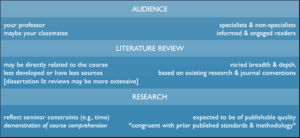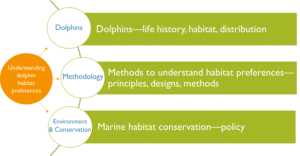Define Discipline-specific Expectations
Late in your undergraduate degree or early into a graduate program, students should become familiar with publication expectations for the discipline:
- What genres are common for graduate students to write in disciplinary coursework?
- What types of genres are commonly published in that discipline?
- What are those publications meant to achieve, and what do they usually look like?
- Are you expected to publish as a graduate student, and how frequently?
These are questions you can ask advisors, mentors, and colleagues. You can also answer these questions yourself by paying close attention to the readings you are assigned for your courses and by looking up articles published in your field on your own.
Consider Genre
As you begin writing your article or revising a previously written piece, consider the genre of a publishable article versus other written pieces. Journal articles should not resemble term papers, dissertation chapters, conference papers, or be mere academic demonstrations. An article has a clear, concise, and precise argument or thesis that contributes to a field of scholarship. Articles are a demonstration of how a scholar’s work expands, complicates, or enhances a key theory or existing research in a field. Journal articles commonly take specialists or aspiring scholars as their audience, and therefore assume an informed and engaged readership. Literature reviews and other sections may vary in length and depth according to the standards of each field, journal, and the extent of existing research.
Seminar Paper Publishable Article

When writing a journal article, you should examine potential journals to ensure that you are adhering to their requirements as you revise. It is especially important to make sure the methodology you adopted in your research adheres to the methodology requirements of the journal(s) you are considering submitting your work to.
Choose a Journal
First, consider which journals you have read or cited the most in your research and coursework. Some of these may be good fits for your work.
Before writing, you should consider what you want to be the main topic or research question. From there, think about whether that research question would fit best at a journal with a broad or narrow scope. A couple of questions to ask yourself: How do you want to present your discussion? What is important about this study? Who would be interested in the results? Once you answer those questions, use your answers to help determine what journal to publish in and what to focus on in the different sections of the article.
Have more than one journal in mind:
- a reach: very prestigious, more competitive;
- a solid fit: prestigious, competitive, but whose work mirrors well the quality and scope of your current research;
- a third option: respected, more open to first time or graduate publications.
Prioritize your target journal based on fit and your purpose behind publishing. You can only submit an article to one journal at a time.
Before you submit your work make sure you have adhered to all requirements of the journal, especially those outlined in their “information for authors” section. It is not uncommon for good work to be rejected for not adhering to journal requirements. Finally, learn what the journal’s evaluation process looks like and how long it typically takes. This can allow you the opportunity to plan ahead for further publications and have a plan in place in case you need to resubmit a piece.
You might also consider how your work will be published, i.e. online or in print, and what restrictions will be placed on how your published work can be shared.
Framing and Journal Selection
In the example below, the student is starting with research about understanding the habitat preferences of dolphins for conservation and environmental policy In this example, if they decide the most important part is:
Dolphins – If the student decides to focus their article on dolphins specifically, then they may choose a journal about marine mammal research and focus on the biology and ecology of dolphins.
Methodology – If the student chooses to focus on the methods behind their research, then they may want to discuss what methods they used and why those methods are important. In this case, they may choose a journal that focuses on that particular methodology and other studies that utilize it.
Environment and conservation – If the student wants to talk broadly about how understanding dolphin habitat preferences could impact policy or marine habitat conservation, then they could choose a journal that focuses on broader topics like conservation.

Predatory Journals
What is a predatory journal?
Predatory journals are publishers that take advantage of “publish or perish” anxieties for academics. They are often characterized by soliciting articles from graduate students and instructors via flattering emails, charging hundreds of dollars to publish an article, and not performing any rigorous peer review or editing of a scholar’s work. In some cases predatory journals will force authors to sign over the copyright of their work, making it difficult or impossible to have their work removed from a predatory publishing site or have it republished elsewhere. In order to feign credibility, such journals have been known to list made up names on their editorial board, or even to list the names of real scholars without their permission.
Red Flags:
- The journal reaches out to the potential author.
- The journal refers to the potential author as “Dr.” regardless of credentials.
- The email, journal website, and available articles from the publication contain multiple spelling and grammatical errors.
- Article submissions are done via email rather than via portal.
- The journal has an inconsistent publishing cycle.
- The journal does not adhere to any standard indices (i.e. ISSN, DOI) or these cannot be verified.
- Article processing fees are not clearly listed or broken down on the journal’s website, they keep changing, or the journal tries to negotiate the fee with you. Legitimate journals will not ask for payment until after your work has been accepted.
- The journal lists an unrealistic publication timeline. Remember that the publishing process takes a long time for a reason (i.e. peer review, fact checking, general vetting).
- The journal guarantees publication (so called “pay to publish” journals).
- The journal or the person contacting you has inconsistent or confusing contact information.
- The name of the journal is too similar to a well-known or well-respected journal.
- The journal has too large of a scope.
How Predatory Publishing Causes Harm
Publishing in predatory journals can be very harmful to the reputation of the author, particularly for graduate students and early-career scholars. In a similar vein, predatory journals often keep poor archives or take down articles without notifying the authors, making it difficult for others to find and cite one’s work or for the existence of your work to be verified. All of this can impact future funding opportunities for scholars.
Additionally, supporting predatory publishers proliferates the spread of inaccurate and potentially harmful information. Since there is little to no vetting process performed by these journals, publishing with them risks degrading the quality and reliability of the body of literature associated with a particular field—and thus the field itself. These journals are particularly dangerous for healthcare and healthcare adjacent fields as circulating unvetted information can harm patients.
Resources
- As awareness of predatory publishers has grown, multiple blacklists have begun to circulate on the internet. Beall’s list is one such resource.
- Talk to a librarian! Librarians are very familiar with databases and resources and are excellent resources for sniffing out predatory journals.
- Check the journal’s title against cites such as the Directory of Open Access Journals (DOAJ) or the Open Access Scholarly Publishers Association (OASPA).
- Check for the journal on multiple databases. Do not simply check Google Scholar, as predatory journals are still indexed on this site.
